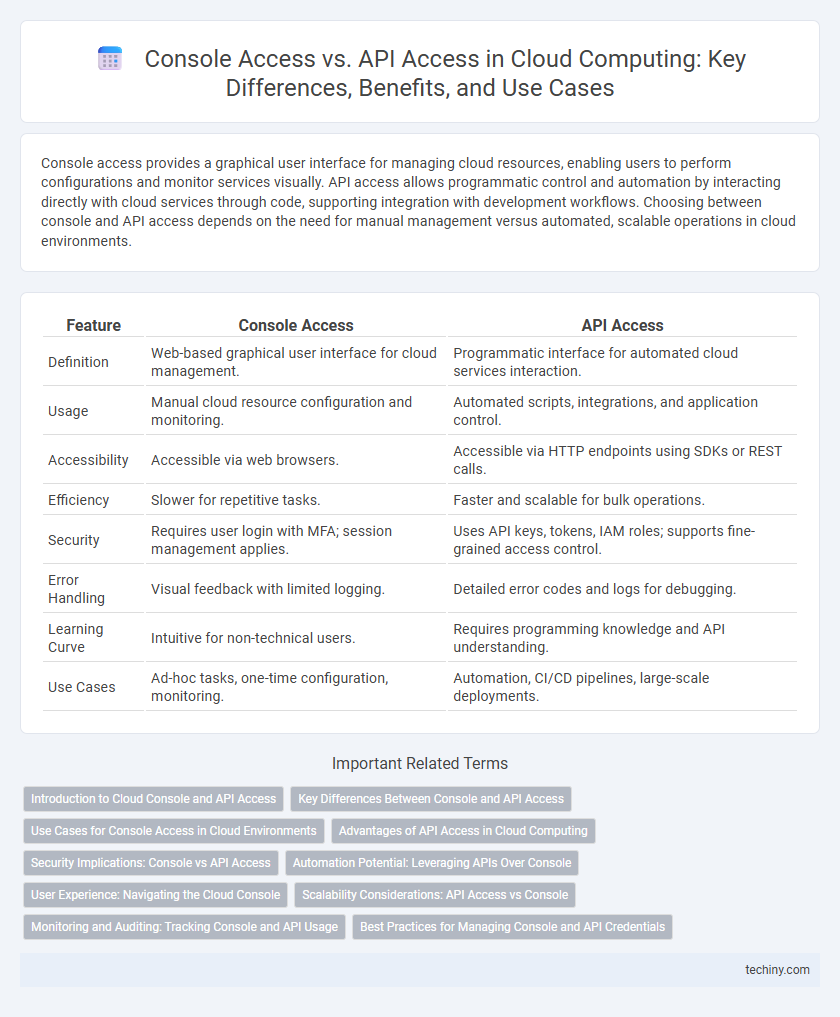Console access provides a graphical user interface for managing cloud resources, enabling users to perform configurations and monitor services visually. API access allows programmatic control and automation by interacting directly with cloud services through code, supporting integration with development workflows. Choosing between console and API access depends on the need for manual management versus automated, scalable operations in cloud environments.
Table of Comparison
| Feature | Console Access | API Access |
|---|---|---|
| Definition | Web-based graphical user interface for cloud management. | Programmatic interface for automated cloud services interaction. |
| Usage | Manual cloud resource configuration and monitoring. | Automated scripts, integrations, and application control. |
| Accessibility | Accessible via web browsers. | Accessible via HTTP endpoints using SDKs or REST calls. |
| Efficiency | Slower for repetitive tasks. | Faster and scalable for bulk operations. |
| Security | Requires user login with MFA; session management applies. | Uses API keys, tokens, IAM roles; supports fine-grained access control. |
| Error Handling | Visual feedback with limited logging. | Detailed error codes and logs for debugging. |
| Learning Curve | Intuitive for non-technical users. | Requires programming knowledge and API understanding. |
| Use Cases | Ad-hoc tasks, one-time configuration, monitoring. | Automation, CI/CD pipelines, large-scale deployments. |
Introduction to Cloud Console and API Access
Cloud Console provides a graphical user interface that allows users to manage cloud resources visually and perform administrative tasks without coding. API Access offers programmatic control by enabling interactions with cloud services through RESTful endpoints, supporting automation and integration into existing workflows. Both methods serve distinct purposes: Console Access is ideal for manual configuration and monitoring, while API Access excels in scalable, automated cloud management.
Key Differences Between Console and API Access
Console Access provides a graphical user interface (GUI) for managing cloud resources, allowing users to interact with services visually through dashboards and forms. API Access offers programmatic control via RESTful endpoints, enabling automation, integration, and scalability by sending requests directly to cloud services. Key differences include ease of use, with Console Access suited for manual operations and API Access tailored for automation and advanced scripting capabilities.
Use Cases for Console Access in Cloud Environments
Console access in cloud environments is ideal for tasks requiring direct interaction with virtual machines, such as troubleshooting, configuration, and real-time monitoring. It allows administrators to access the system's graphical or command-line interface without network dependencies, ensuring availability even during network outages. Console access also supports initial setup and emergency recovery scenarios where automated API calls are infeasible.
Advantages of API Access in Cloud Computing
API access in cloud computing enables automated, programmatic control of resources, significantly enhancing scalability and efficiency. It allows integration with DevOps tools and CI/CD pipelines, facilitating rapid deployment and management. APIs also provide fine-grained access control and monitoring, improving security and operational visibility.
Security Implications: Console vs API Access
Console access involves direct user interaction through web interfaces, presenting risks such as phishing and session hijacking if proper multi-factor authentication (MFA) is not enforced. API access, while enabling automated and programmatic control, requires stringent token management and encryption to prevent unauthorized access and API abuse. Both access methods demand robust audit logging and role-based access control (RBAC) to minimize security vulnerabilities in cloud environments.
Automation Potential: Leveraging APIs Over Console
APIs offer superior automation potential compared to console access by enabling direct interaction with cloud services through programmable interfaces, facilitating seamless integration into DevOps pipelines and automated workflows. Console access, while user-friendly for manual configuration, lacks scalability and repeatability essential for continuous deployment and infrastructure as code practices. Leveraging APIs accelerates cloud resource management, reduces human error, and supports sophisticated automation strategies critical for efficient cloud operations.
User Experience: Navigating the Cloud Console
Navigating the cloud console offers an intuitive graphical interface designed for users of all skill levels, enabling seamless management of cloud resources through dashboards and visual tools. Console access simplifies tasks like monitoring, configuration, and deployment by providing direct interaction with services, reducing the learning curve compared to API-based operations. This user-centric design enhances productivity by allowing quick access to real-time data and streamlined workflows without requiring extensive coding knowledge.
Scalability Considerations: API Access vs Console
API access enables greater scalability in cloud computing by allowing automated, programmatic interactions with cloud services, facilitating rapid deployment and management of resources at scale. Console access is typically limited to manual operations, making it less efficient for handling large-scale or complex environments. Enterprises leveraging API access can integrate cloud resource management into continuous deployment pipelines, enhancing scalability and operational efficiency.
Monitoring and Auditing: Tracking Console and API Usage
Monitoring console access involves tracking user logins, session activities, and access frequency to identify unauthorized attempts and ensure compliance with security policies. API access monitoring requires logging API requests, response codes, and usage patterns to detect anomalies and maintain audit trails for automated interactions. Combining both console and API usage data enhances comprehensive visibility into user behavior and strengthens security auditing in cloud environments.
Best Practices for Managing Console and API Credentials
Secure management of console and API credentials involves implementing strong authentication methods such as multi-factor authentication (MFA) and regularly rotating access keys to minimize risk exposure. Using role-based access control (RBAC) ensures users and services have only the permissions necessary for their tasks, reducing the attack surface. Logging and monitoring all access attempts help detect unauthorized activities and maintain compliance with security policies.
Console Access vs API Access Infographic

 techiny.com
techiny.com